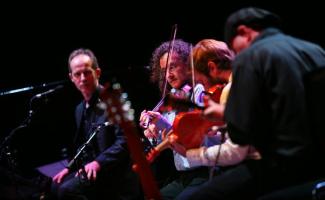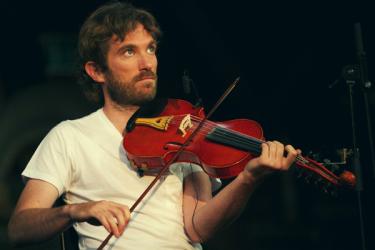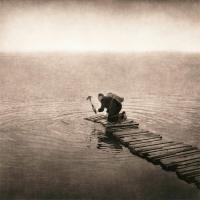I have been a devoted fan of Martin Hayes and Dennis Cahill, the phenomenal fiddle/guitar duo who have pushed the boundaries of traditional Irish music to create a uniquely beautiful sound that is stunningly hypnotic and other-worldly. I first discovered them in 1998 at Celtic Connections in Glasgow, Scotland where they put on a performance that held captive every open heart in  the auditorium. They have performed many years together, and are now in a collaboration with Irish-born musicians Iarla O Lionaird and Caoimhin O Raghallaigh, and American Thomas Bartlett performing to sold-out audiences in the UK and beyond. The first album takes the name of their band–The Gloaming, and features Martin Hayes on fiddle, O Raghallaigh on the hardanger (a 10-string fiddle), Cahill on guitar, Bartlett on piano, and O Lionaird on vocals (singing in Irish Gaelic). Their union has produced an album of mysterious and enchanting beauty, pushing the boundaries of Irish music even farther, even as they pull not only from tradition, but from the free expression they each individually have developed in a quest to give their own unique voices to the music they make.
the auditorium. They have performed many years together, and are now in a collaboration with Irish-born musicians Iarla O Lionaird and Caoimhin O Raghallaigh, and American Thomas Bartlett performing to sold-out audiences in the UK and beyond. The first album takes the name of their band–The Gloaming, and features Martin Hayes on fiddle, O Raghallaigh on the hardanger (a 10-string fiddle), Cahill on guitar, Bartlett on piano, and O Lionaird on vocals (singing in Irish Gaelic). Their union has produced an album of mysterious and enchanting beauty, pushing the boundaries of Irish music even farther, even as they pull not only from tradition, but from the free expression they each individually have developed in a quest to give their own unique voices to the music they make.
Beyond their ground-breaking album, there is a new documentary out about the backgrounds of the musicians and how they came to unify into the band called The Gloaming: Moment to Moment produced by South Wind Blows out of Ireland. I was fortunate to get an exclusive viewing of this video via a podcast out of the UK called Soundings (webisodes are free to listen to through Itunes). The show traces through interviews with each band member their musical roots, how their paths crossed early on in their musical journeys, and how they came to put together such a stellar collaboration. The documentary also contains live performances from their latest album.

Martin Hayes
Rare archival footage includes a young Hayes performing with his own father and other musicians from his hometown; O Raghallaigh developing alongside his musician relatives and friends; and O Lionaird singing a beautiful Gaelic ballad in his youthful tenor voice at a local festival. Hayes and O Lionaird knew each other as youngsters, and Hayes remarked on his admiration for the lad’s singing, saying, “I felt a close affinity with him because I felt he was trying the same thing that I was trying to do.” That being, developing a unique voice in the midst of a vast sea of traditional virtuosic musicians who at the time stuck closely to the ties of the past. O Lionard is known now as a pioneer and developer of Sean Nós Song, a traditional style of Irish solo singing that is highly ornamented. The documentary focuses on the three County Clare musicians in their individual struggles to maintain the heart of Irish tunes, yet to push it in a modern direction. O Raghallaigh spoke of how he developed his skills by emulating certain great Irish fiddlers, paying close attention to re-create their performances of tunes. But eventually he became happy with allowing the tunes to develop their own voice and come out of him in an original way. Hayes journey led him to America where he experimented in bands by mixing genres–a rebellion of sorts to grasp a hold of possibilities beyond the isolated community he had come from. His first solo album caused a stir in traditional circles. Some loved the direction he took Irish music in, while others found it offensive.
But his album had a life-changing effect on a 10 year old Bartlett, whose family took a week in Ireland on their way to moving to India for a year. Bartlett was already a fan, and discovered in an Irish magazine that Hayes was touring in the area. His family followed Hayes the entire week, showing up in every show. This was the birth of his relationship with Hayes, who finally noticed him and approached him. Hayes kept an eye on Bartlett’s career after he, at the age of 12, managed to book a show in Vermont for Hayes to play. In spite of being a life-long fan of Hayes, Barlett’s musical influences came from many directions, and not growing up in an environment of Irish music, he believes, lends to his creativity in the band: “I never recognized those structures or was particularly interested in them, which is maybe why this band is working well. I don’t recognize the lines that, to the rest of this band, they see those lines and are clearly happy to get outside of them. But it’s hard when you are so aware of what is ‘meant’ to be done. And the fact that I have absolutely no idea of what is meant to be done makes those lines disappear.”
 While of Irish descent, Dennis Cahill grew up in Chicago to parents who embraced the American culture full-force. Within that arena, Cahill’s musical influences came from folk music of the 60’s, rock and roll, and his training in music school. “Coming into the music late, the one thing that is difficult about it is there’s no nostalgia to it. I can’t listen to something and say, ‘Oh, I remember when I heard that when I was 12.’ It kind of floats on it’s own merits to me…it either works or it doesn’t.” Hayes says of Cahill that they collaborate so well together because Cahill is a minimalist and leaves space in his accompaniments. Cahill, after playing with Hayes awhile early on, discovered that he didn’t have enough knowledge of Irish tunes to really do them justice, and so began sitting in on Celtic music sessions to learn the tunes and where to “bend.” He says, “The tunes are so well written, it’s amazing. They are really gems of music that any composer would be delighted to come up with. It’s the mark of a great piece of music–it’s bendable and it doesn’t lose it’s integrity.”
While of Irish descent, Dennis Cahill grew up in Chicago to parents who embraced the American culture full-force. Within that arena, Cahill’s musical influences came from folk music of the 60’s, rock and roll, and his training in music school. “Coming into the music late, the one thing that is difficult about it is there’s no nostalgia to it. I can’t listen to something and say, ‘Oh, I remember when I heard that when I was 12.’ It kind of floats on it’s own merits to me…it either works or it doesn’t.” Hayes says of Cahill that they collaborate so well together because Cahill is a minimalist and leaves space in his accompaniments. Cahill, after playing with Hayes awhile early on, discovered that he didn’t have enough knowledge of Irish tunes to really do them justice, and so began sitting in on Celtic music sessions to learn the tunes and where to “bend.” He says, “The tunes are so well written, it’s amazing. They are really gems of music that any composer would be delighted to come up with. It’s the mark of a great piece of music–it’s bendable and it doesn’t lose it’s integrity.”

O Raghallaigh
O Lionaird approached Hayes with the idea of collaborating, and Hayes, who had watched Bartlett’s career advance in New York, saw him as a good addition to the band. He then thought that with a guitar and piano, he may need some strength from another fiddler, and so brought in O Raghallaigh on hardanger. O Raghallaigh explains, “I play a stunning 10-string instrument made by Norwegian luthier Salve Hakedal. The top five bowed gut strings plus the five sympathetic strings below give the fiddle a wonderful resonant sound. It is somewhere between a hardanger fiddle and a viola d’amore. While Salve calls the instrument a 5+5, and Dan Trueman (for whom the first one was made) calls his a 5×5, I’ve decided mine likes being called a Hardanger d’Amore.” Hayes felt that their styles were different, yet complimented each other, so he completed the mix.
While some of the album is reminiscent of the Hayes/Cahill established “sound,” adding the other three to the mix has brought a new level to the music in texture, nuance, and harmony that is refreshingly exciting. The opening track is so hauntingly dissonant yet gorgeous with O Lionaird’s Irish dialect cutting through the lamenting strains of dual fiddlers–there is an amazing affect of captivation. Bartlett touched on the power of the collaboration in his praises for Martin Hayes that so succinctly sum up his gift as a fiddler: “He (Hayes) really plays with time in a way that is astonishing to me. That trans-state that he gets into, that he’s able to draw other people into–it’s a really unusual thing. He’s so patient. He’s willing to take as long as it takes, and you can be sitting there thinking, ‘Oh, this music is astonishingly beautiful,’ and, ‘Oh, what a nice variation to the melody he did,’ and you don’t realize he is actually slowly circling you with this net until he’s got you in a place you didn’t think you were going to get to. And he can do that every time.”
He did that very thing for me when I saw him live, and I am still under his spell. And I am now submerged in new sounds married to old in this latest album, now available at Itunes, Amazon.com, and other online stores. Buy the album and the documentary if you want a firsthand glimpse into the culture of Irish music and how it is evolving in the lives of these amazing members of The Gloaming.




